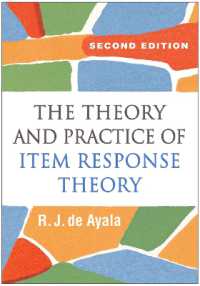Full Description
Through its impact on students in their lives in and beyond college, and recognizing the porous boundary between the classroom and the "real world," SoTL can offer insights into broader societal issues, offer evidence of activities that facilitate everyday learning, promote intrinsic motivation, better support people from underrepresented communities, or uncover the ripple effects of changing educational environments. It has the potential to deliver messages of broad public interest. This book extends the field-building work of Boyer's Scholarship Reconsidered and Hutchings, Huber, and Ciccone's The Scholarship of Teaching and Learning Reconsidered by taking a new look at SoTL's ubiquitous call to "go public." Going Public Reconsidered explores the potential impacts of knowledge generated by SoTL, considers its varied public audiences, and offers guidance for the appropriate media and modes of communication to reach them, including the use of social media. It urges the SoTL community to step up and contribute its expertise to conversations about the crises that face our communities, nations, and the world, and disseminate the relevance of its research for the world outside of the classroom.Recognizing that many practitioners find it difficult to conceptualize the public in public SoTL beyond the higher education audiences they routinely address, this book focusses on conceptualizing, planning, and shaping the message, and clarifying appropriate audiences. It offers guidance on the "who" and the "how" of public SoTL. Going Public Reconsidered addresses such questions as: ● What is happening in the world that would benefit from a SoTL-informed perspective?● What information, insight, or knowledge does SoTL generate?● Who beyond higher education might care about this information, insight, or knowledge, and why?● How can we adapt to the venues and platforms where they currently get their information and knowledge?The fifteen editors and contributors explore the potential and the implications of extending SoTL beyond its current horizons by reflecting on the ultimate responsibility of those who profess SoTL; examining SoTL's audiences and the notion of "the public"; considering what topics and Grand Challenges public SoTL might address; offering case studies of outreach in the US and abroad; and providing guidance on the use of social media for public SoTL - from Twitter, Facebook, LinkedIn, and YouTube to blogs - as well as on developing relationships with mainstream media. The book's message is that public SoTL isn't a radical departure from SoTL-as-we-know-it, but a natural expansion of its methods and goals, offering the potential of broadening its impact domestically and internationally. It offers inspiration and challenges to practitioners across the globe.
Contents
Foreword—Michele DiPietro and Hillary H. Steiner Preface—Nicola Simmons Introduction. A Framework for Public SoTL— Jennifer C. Friberg and Nancy L. Chick 1. Public SoTL:Amplifying SoTL's Purposes, Audiences, and Products —Nancy L. Chick 2. Going Public with SoTL as Social Activism —Kasturi Behari-Leak 3. Passive Receptacles and Misguided Benevolence:On the Inside/Outside Dichotomy at the Root of Public Scholarship —Claire A. Lockard and Stephen Bloch-Schulman 4. Determining SoTL's Grand Challenges: Advocating for the Broader Endeavor of the Scholarship of Teaching and Learning —Lauren Scharff and Claire Hamshire 5. SoTL and Knowledge Translation —Lorelli Nowell and Jennifer C. Friberg 6. Social Media and Public SoTL —Jessie Moore, Claire Hamshire, and Peter Felten 7. Making SoTL Public Using Weblogs —Jennifer C. Friberg, Lauren Scharff, John Draeger, and Aaron S. Richmond 8. SoTL and Traditional Media —Lee Skallerup Bessette 9. Reflecting on Global Efforts in Knowledge Demoncracy and SoTL Collaborations —Janel Seeley Editor and Contributor Biographies Index








